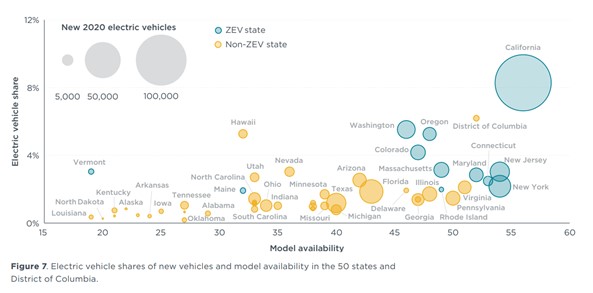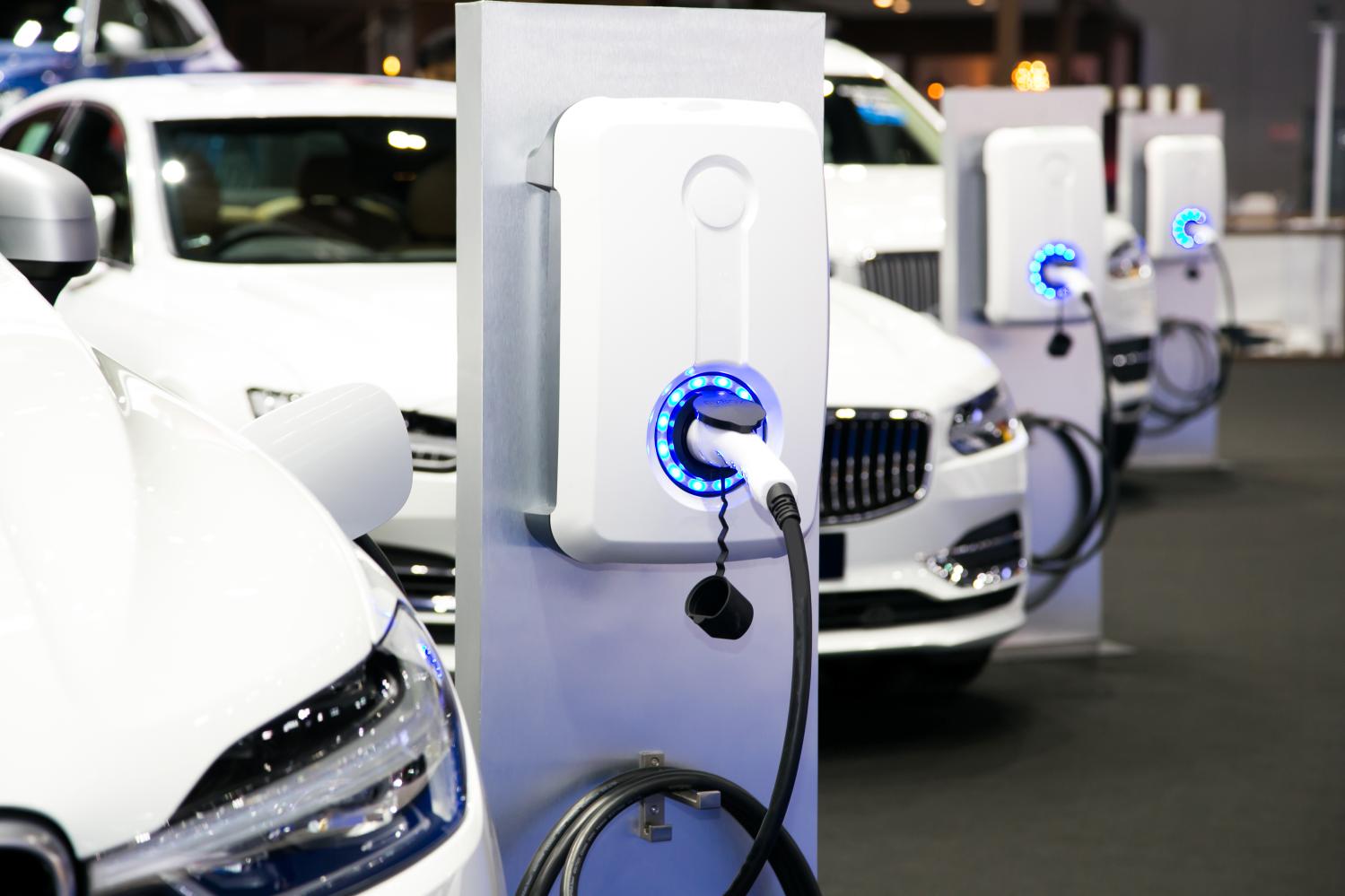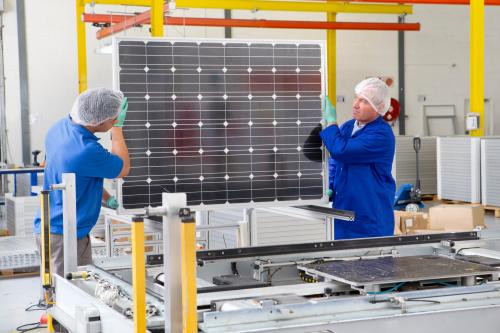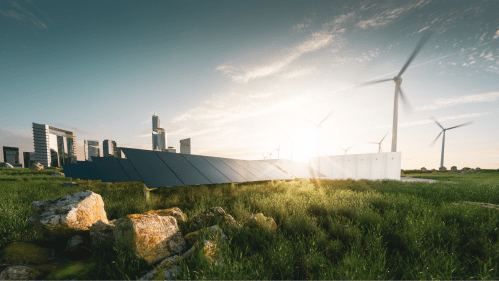Within weeks of the Russian invasion of Ukraine, the average price for a gallon of gasoline reached its highest point in American history—a range where it has largely remained as the economic isolation of one of the world’s largest petroleum exporters looks to persist for months, if not years.
Ninety-one percent of American households own a car, meaning that almost everyone will feel the sting of elevated fuel prices when they fill up their tanks for the foreseeable future. However, the roughly 2 million owners of electric vehicles (EVs) will be spared the pain at the pump.
An oil shock of the magnitude not seen since the 1973 Arab Oil Embargo has sent Google searches related to EVs surging by 300 percent in the last few months. Thirty-six percent of Americans now say they plan to buy or lease an EV or are seriously considering doing so. The time is ripe to electrify American roads.
Increasing the ownership and production of EVs presents a strategic opportunity to not only insulate the public from price spikes in oil, but also boost the clean manufacturing workforce and decarbonize the transportation sector—the largest source of CO2 emissions in the United States.
There are challenges to overcome in this transition, not the least of which is an insecure supply of raw materials. Rather than relying on Russian oil, the U.S. would have to rely on Chinese lithium-ion batteries, at least for now. Other challenges include high costs, inventory shortages, a lack of charging infrastructure, and the need to move away from fossil fuels for EV charging.
So far, Congress has authorized $7.5 billion from the bipartisan infrastructure bill to build a nationwide network of half a million charging stations. President Biden has issued a flurry of executive actions including fully electrifying the federal fleet by 2035, invoking the Defense Production Act to shore up a domestic supply chain of critical minerals like lithium, nickel, and cobalt for EV batteries, and tasking the Department of Transportation (DOT) and Environmental Protection Agency (EPA) to devise new vehicle emission standards.
There is an opportunity to go further. Congress, cities, and states can extend and expand monetary incentives for buying EVs and building public charging points. The Biden administration can issue a national Zero-Emission Vehicle (ZEV) mandate, which has already been enacted in fifteen states, requiring automakers to sell a certain number of EVs each year. Everyday people can raise awareness about EV driving ranges, charger access, maintenance costs, and the environmental benefits.
Importantly, public and private R&D investment should urgently go into two projects. First, we need investment to develop solid-state batteries as an alternative to the mineral intensive and foreign made lithium-ion batteries. Second, we should invest in smart grid technologies like “managed charging” which can optimize the charging of your vehicle when there are renewable energy sources on the grid.
The case for EVs: Energy security, emissions, and employment
In 2021, the United States consumed a world leading 19.78 million barrels of petroleum per day, 30 percent more than China in second place. Nearly two-thirds of it is used in the transportation sector, with 43 percent being imported from 73 different countries. The U.S. spends an exorbitant amount of money securing the transit chokepoints around many of these nations who also manipulate the global oil market through unpredictable and anti-competitive behavior.
To make matters worse, the greenhouse gases (GHGs) emitted on American roads are the largest slice of all U.S. emissions (29 percent), with passenger cars and light-duty trucks making up the bulk of use. These emissions include not only carbon dioxide but other GHGs like methane, nitrous oxide, and hydrofluorocarbons which have even greater warming potentials.
Increasing the adoption of EVs could be a promising solution to both reduce American dependence on foreign oil and curtail a significant source of CO2 emissions. Any emissions generated by EV charging are vastly offset by the absence of tailpipe emissions, even with current levels of fossil fuels on the grid and without factoring in expected decreases in the power sector’s carbon intensity.
The World Resources Institute estimates that 22 times as many EVs are needed by 2030 to help keep warming below 2 degrees Celsius, which corresponds to roughly 50 million EVs in the U.S. alone. Right now, less than 1 percent of the 250 million cars, SUVs, and light-duty trucks on U.S. roads are electric. Globally, the path to net-zero in 2050 requires 61 percent of global new passenger vehicle sales to be zero-emission vehicles by 2030 and 100 percent by 2038, according to a recent BloombergNEF analysis.
In light of today’s tight oil markets, IHS Markit forecasts that an aggressive adoption of EVs could slash U.S. oil demand by nearly a third—down to 7 million barrels per day by 2050. However, EVs would simply shift the energy dependence paradigm from foreign oil producers to countries like China, Chile, and Australia, who mine and process the minerals needed for EV batteries. This might change with U.S. investments in domestic mineral production and recycling capabilities, as well as different battery chemistries which shed these dependencies.
Finally, EVs could be an even bigger boon to American manufacturing than traditional gas-powered cars. A study from the Argonne National Laboratory found that a higher fraction of plug-in EVs had their components assembled in the U.S. compared to non-EV cars. One analysis found that the U.S. could create up 150,000 new jobs and would protect existing auto manufacturing jobs from being offshored if the U.S. took the lead in EVs. The field employs workers from a diversity of backgrounds beyond automotive technicians and assembly workers to include the electrical industry and scientists pushing the boundaries of battery technology.
Recognizing these benefits, the U.S. first embarked on a national effort under President Obama in 2009 to get 1 million EVs on the road by 2015 through a $7,500 federal tax credit. The tax credit has remained the flagship federal effort to make EVs less cost-prohibitive for consumers while numerous states have stepped in with their own incentives, including free parking, waiving vehicle registration fees, and road lane benefits.
The Biden administration looks to pick up where the Obama administration left off. While the menu of policy options has gotten much more diverse, the challenges are more complex. Luckily, we can draw lessons from the successes and failures of various American states and foreign countries who faced these barriers and now boast the highest percentage of EVs on the road.
Money talks: Tax credits and subsidies work
Cost remains a top concern for prospective EV buyers. A recent consumer survey found that among respondents who were not planning to buy an EV, 52 percent pointed to costs. Cash incentives for EVs can and have changed minds. In 2015 the state of Georgia abruptly phased out its $5,000 EV tax credit and replaced it with a $200 annual registration fee. The EV market tanked, with sales plunging by 80%. Georgia went from having the second highest market share of EVs by state (after California) to the twenty-first.
Congress is on the verge of making a similar mistake nationally. The existing $7,500 tax credit for consumers phases out after an automaker sells 200,000 qualifying vehicles. Ford is expected to max out the limit this year with Nissan soon to follow in 2023. Tesla and General Motors already hit the cap in 2018 and Toyota just hit the cap this summer.
Current legislation to expand the tax credit to $12,500 and making it refundable is stalled. While talks are still ongoing, negotiators should push not only to expand the credit but also raise the cap to on the number of eligible vehicles to at least 600,000 to meet the surging consumer demand. They could even eliminate the cap on the tax credit altogether to keep sustained momentum for EV adoption.
More ambitious proposals could also be on the table. These would include direct subsidies in the form of one-time grants or rebates for EV purchases and charging infrastructure, in addition to waiving registration fees. We know these policies have worked at the state and local level—the top 11 metropolitan areas in the U.S. with the highest uptake of EVs had state, city, and utility purchase incentives ranging from $1,500 to more than $5,500.
Incentives like this would pull the price of the Chevy Bolt, the cheapest EV in the U.S. at a base price of $26,595 with roughly 260 miles of range, under its gas-powered contemporary—the $25,395 Toyota Camry. It would also put the $39,947 Ford F-150 Lightening in better competition with its gas-guzzling rival—the $35,900 Dodge Ram. More work needs to be done to inform the public on the cost side as 46 percent of Americans in a recent poll were unaware of federal and state purchase incentives for EVs.
National-level policies have proven effective as well, not just for purchasing EVs but building charging points. European countries gave one-time grants ranging between 1,000 euros (Sweden) to 6,000 euros (France) and reduced vehicle registration fees. Norway took the furthest step by exempting EVs from paying value-added tax (VAT) which amounted to 25 percent of the vehicle’s net price.
The Netherlands, Austria, Finland, and Spain embarked on expansive national subsidies aimed at homeowners, companies, and municipalities to build charging stations on-premise. Stockholm incentivized construction of more charging points by giving away land free-of-charge in exchange for electricity companies paying for the installation.
Today, European countries represent seven out of the ten nations with the highest percentage of EVs on the road. Norway, Iceland, Sweden, the Netherlands, and Finland comprise the top five. The Netherlands has the highest density of EV chargers in the world. Overall, light-duty electric vehicles account for approximately 90 percent of all new vehicle registrations in Europe. In the first quarter of 2022, the U.S. was at 5.9 percent.
Unfortunately, EV incentives like these are caught in America’s political gridlock. The sustained rise in inflation has dampened the appetite for bold new federal spending as well as opposition from the critical 50th vote on any new legislation. Senator Joe Manchin (D-WV) opposed and removed EV tax credit measures under the infrastructure bill and has long held fears about new government spending exacerbating inflation. EV subsidies again are on the chopping block during this summer’s negotiations on a new social spending bill.
In this light, a new approach is needed to convince Manchin that tax credits and subsidies—which we know work—are more fiscally palatable. Congress could revisit the Car Allowance Rebate System, more popularly known as “cash for clunkers,” a 2009 vehicle trade-in program that targeted getting fuel inefficient cars off the road.
The program would be re-designed to give consumers a minimum rebate if they trade in their gas-powered car for an eligible EV. That trade-in could be priced based on the make and model of cars which contain many of the scarce raw materials and components needed for EV production—the absence of which has resulted in long EV waiting lists. The gas-powered cars can be scrapped and have their components recycled onto automaker production lines at a set user fee paid to the federal government. In this way, the U.S. government would be able to recoup some of the costs of the rebate, automakers would have a faster, domestic supply chain of key production materials, and an argument could be made to Senator Manchin that this program could be potentially close to deficit neutral.
An electric cash-for-clunkers was already floated by Senate Majority Leader Chuck Schumer (D-NY) in 2019 and could be revived in this round of negotiations of a slimmed down social spending bill. The original program successfully motivated millions to trade in their older gas-powered cars for more fuel-efficient ones, cutting between 8.6 to 28.3 million tons of CO2. A new program for EVs could pull 63 million gas cars off the road and shave off nearly 300 million metric tons of CO2 (based on author calculations).
No cost option: A zero-emission vehicle mandate
If no additional spending from Congress gets authorized, the Biden administration could follow the playbook of fifteen U.S. states in announcing a zero-emission vehicle (ZEV) mandate. This would entail the use of executive action to require automakers to sell a certain percentage of EVs every year to meet regional air quality standards.
In this scheme, automakers are required to obtain credits which they earn through the sale of qualified zero-emission vehicles. These credit requirements will slowly rise over time, but the credits can be tradeable allowing manufacturers who are behind their targets to buy credits from others.
Different vehicles acquire different amounts of credits. For example, an EV will earn a full credit versus a plug-in hybrid car earning partial credits. This is because plug-in hybrids are heavier than gas-powered cars due to a combined battery pack and fuel tank, and as a result they are less fuel efficient and have much higher lifetime CO2 emissions than initially claimed.
California was the first state to adopt a ZEV mandate in 1990 and has since progressively raised the ambition of their credit requirements. In 2018, 4.5 percent of new vehicles sold were required to be a ZEV, now going up to 22 percent in 2025. That will go to 100 percent by 2035, amounting to a full phase out of selling new gas-powered cars.
Fourteen other states have adopted California’s ZEV regulation model, and together these states were responsible for nearly two-thirds of all EV sales in the U.S. in 2020. As shown in the figure below, ZEV states far outpace other states in terms of EV model availability and their share of cars on the road.
Source: International Council on Clean Transportation (2021), Evaluating Electric Vehicle Market Growth Across U.S. Cities. All Rights Reserved.
The success of the ZEV mandate has also been seen in China which introduced its credit system in 2017 known as the New Energy Vehicle (NEV) mandate. Their starting goal was 10 percent of new car sales being EVs, fuel cell cars, or plug-in hybrids. Since then the total sale of EVs has increased by nearly 50 percent every year, going from under 2 million sold in 2017 to more than 5 million in 2020. Today, China has the largest number of EVs in the world at around 5.5 million, more than double the U.S., and the country is aiming to have 18 percent of new car sales be an NEV in 2023.
So far, President Biden has already issued an executive order setting a non-binding target of having 50 percent of all car sales be EVs by 2035. Committing to a binding, national ZEV mandate has a three-fold advantage. First, it could be accomplished with executive action through invocation of the Defense Production Act. Second, it requires limited-to-no government expenditures to establish the credit scheme, so there are no subsidies involved. Third, it pushes the onus onto the automakers to increase their production, reduce prices, and entice consumers in order for them to get EVs out the door and reach their credit requirements.
The downside is that this option could face legal backlash from states who don’t believe the president has constitutional authority to mandate the production and sale of a certain good. Right now, seventeen states are contesting the legality of the EPA’s tailpipe emission standards on similar grounds and its likely they would pursue the same strategy against a national ZEV mandate. A recent Supreme Court ruling limited EPA’s ability to put caps on GHG emissions from power plants, setting up a potential showdown regarding both vehicle emissions or a ZEV mandate in the future.
Automakers like Ford, General Motors, Honda, and Toyota are currently siding with the EPA in the tailpipe emission lawsuit, arguing that the rules are needed to facilitate an important transition for the environment. This raises the prospect that they will legally support a national ZEV mandate as well, though the success of any such defense is unknown given the composition of the Supreme Court.
Spread the word: EVs are cheaper and more reliable than traditional cars
States, cities, and even everyday people can help automakers sell more EVs through public marketing campaigns dispelling core myths around EV affordability and reliability. For example, a recent survey found that 53 percent of Americans would not be willing to pay $500 more for an EV compared to a traditional gas-powered car. However, this ignores that the total cost of ownership (TCO) for any car largely comes down to maintenance, repairs, and fuel costs, not the initial purchase price. Here, EVs overwhelmingly win—their maintenance costs are 40 percent lower than traditional gas-powered cars over their lifetime.
EVs are also three times more mechanically efficient than gas-powered cars, with 59 to 62 percent of the electrical energy being converted into power to turn the wheels compared to 17–21 percent of fuel energy conversion in traditional vehicles. Accordingly, there is no engine oil that needs to be regularly changed or spark plugs, fuel filters, and multi-speed transmissions which are costly to service. The EV battery and motor require minimal to no maintenance and the use of regenerative braking significantly reduces wear and tear on the brakes and replenishes the battery.
Factoring this in with today’s gas prices, EVs are three-five times cheaper to drive per mile than gas-powered vehicles nationally. In certain states like Nevada, Florida, North Carolina, Virginia, Arizona, Tennessee, and Georgia, some EVs are five-six times cheaper to drive due to differences in electricity prices and fuel taxes.
Similarly, there is a perception that EVs don’t have enough range to meet the average person’s driving needs. This fear, known as range anxiety, accounted for 55 percent of respondents in a recent consumer survey who said they were hesitant to get an EV.
The average driver travels roughly 50 miles a day according to the U.S. Federal Highway Administration, many much less than that with the wider adoption of long-term remote work. Even if you doubled this distance you would still have roughly 150 miles available to drive on 25 different models of EVs, including the cheapest model available. These ranges will only get longer as battery technology improves and automakers compete for customers by offering battery swaps and upgrades.
61 percent of Americans in the same consumer survey said their top barrier to buying an EV was charging logistics. Luckily, most owners will be able to charge their EV at home. For others, there are more than 45,000+ charging stations nationally with New Jersey, Arizona, Washington, D.C., California, and Hawaii having the highest density. To that end, half a million new charging stations are coming to a corner near you, making it extremely unlikely that you will be stranded somewhere with a dead car.
These facts could be highlighted through educational ads in multiple languages on TV, radio, and online in concert with a public awareness push from community organizations, faith leaders, businesses, and athletes pitching EVs both as an environmentally important purchase and a way to lessen the burden of fuel costs while supporting American manufacturing.
The end game for EV batteries: Solid-state vs. lithium-ion
An important messaging challenge to overcome is skepticism about the actual extent of EV’s environmental benefits. This skepticism falls in two buckets: the environmental cost of producing EVs themselves, particularly the batteries, and whether charging your EV is simply increasing the amount of fossil fuels burned on the grid.
There is truth to both of these concerns. A recent experiment by the University of Toronto compared two popular midsize sedans—an electric Tesla Model 3 and a traditional Toyota RAV4. By the time both cars rolled off the assembly line, the Tesla had actually generated 65% more emissions than the RAV4 because of the metals needed for the lithium-ion battery.
However, once the cars hit the road the tide starts to turn. At 20,600 miles the lifetime emissions of both vehicles are roughly the same. At 100,000 miles, the lifetime emissions of the RAV4 are 77% more than the Model 3, assuming that the Tesla charges with national averages of the electricity mix. What’s clear from this experiment is that EVs are unequivocally cleaner than gas-powered cars over their lifetime, but there is room for improvement.

Electric vehicles use six times more minerals than conventional gas-powered cars. Most of them go to the lithium-ion battery, which is made up of lithium as well as significant amounts of graphite, manganese, cobalt, nickel, and copper.
Since the invasion of Ukraine, the price of nickel has skyrocketed due to Russia’s role as a leading producer of battery-grade nickel. Copper prices have risen 70 percent during the pandemic. China dominates around 70-80 percent of global critical minerals processing as well as 80 percent of battery cell manufacturing capacity. Part of this dominance is due to the fact that China is home to roughly a third of global rare-earth mineral reserves, but where it lacks access to its own raw materials it has heavily invested in mining projects abroad, like the Democratic Republic of Congo, where 60 percent of cobalt ore comes from.
Alternative battery chemistries can be a pivotal tool to reduce reliance on minerals from other countries and help develop a more resilient EV supply chain.
Solid-state batteries have been described as the “end game” for electric vehicles. They’re not filled with flammable liquid electrolytes which makes them safer and cheaper. They are simpler to recycle and can achieve a 70 percent greater volumetric energy density, which allows for a longer driving range, lighter battery packs, cheaper cars, and the ability to reach a full charge within 10 minutes. Finally, they require much fewer critical minerals, eliminating the need for graphite and cobalt altogether. This results in drastically lower costs and upfront emissions and can be a strategic alternative to lithium-ion batteries, access to which depends on staying in China’s good graces amidst a fraught geo-economic rivalry that shows few signs of abating.
The greatest challenge for solid-state batteries has been scaling production and making them commercially viable. The best estimates right now project that solid-state batteries won’t hit the mass market for EVs for another three to five years. DOE has unleashed $209 million from the bipartisan infrastructure bill for 26 new projects with the national laboratories looking into advanced batteries, including solid-state batteries. This is a paltry amount compared to Toyota’s planned investment of $13.5 billion in partnership with Panasonic to develop solid-state batteries. Ford, BMW, and Volkswagen are also aggressively investing in this technology.
DOE has engaged in some initial public-private partnerships to accelerate the testing and production scaling of solid-state batteries, but the Biden administration can go further. This could include directing the General Services Administration (GSA) and other federal agencies to establish purchase guarantees with auto manufacturers to get access to the first EVs with solid-state batteries, in line with Biden’s executive order requiring the entire federal fleet of vehicles to go electric by 2035.
With a federal fleet of more than 645,000 vehicles, purchase guarantees of this volume will help commercialize the technology, catalyze additional private sector investment, and bring costs further down.
Managed charging: Powering your EV with clean energy
Along with next-generation batteries, DOE could scale up smart grid charging technologies to further decarbonize EVs. The degree of carbon emitted during EV charging depends heavily on the time of day that charging occurs.
In Europe, one study found that charging in the afternoon when the sun is more prevalent and solar power is being generated would save 16-18 percent more CO2 emissions than in the evening when their grids are fueled more by gas and coal.
A global study across 59 regions found that EV charging had lower emissions than gas-powered cars in 95 percent of the world—the only exception being countries like Poland where electricity generation is almost entirely from coal.
The solution to this problem is called “managed charging” also known as intelligent or adaptive charging. This allows a utility or third-party to remotely control the charge of the EV to better correspond with load management on the grid, and to time it for higher periods of renewable production like mid-day for solar and night-time for wind power.
Cars are typically stationary for up to 22 hours a day and are sitting a few hundred feet or less from existing electrical infrastructure. This presents a significant opportunity to manage residential and workplace charging on a predictable schedule when they are unused for significant portions of the day. In a recent survey of utilities, more than 50 percent of respondents were looking to implement managed charging programs within the next two years as the uptake of EVs increases nationally.
DOE can step up to invest in the necessary technology and regulatory signals to make managed charging successful. The three most impactful things utilities have signaled they need is (1) industry consensus around managed charging protocols (e.g., messaging platforms for bi-directional data flows between the grid and the vehicle), (2) a managed charging program design which factors in electricity rates and opt-out abilities for consumers, and (3) regulatory support to allow utilities to experiment with managed charging.
DOE could create working groups to bring together utilities, grid operators, charging station developers, and regulators to synchronize on necessary policy changes so that EV charging is done as cleanly as possible and in a sustainable way for grid management. This includes pushing the envelope on new innovations like Vehicle-to-Grid (V2G) systems where EV batteries act as energy storage units on the grid which can be dispatched for power in exchange for reduced charging fees and other incentives.

Conclusion and key recommendations
With gas prices at their highest point in 40 years, the U.S. once again stands at a crossroads of how it will respond to a global oil crisis. In 1973, the Nixon administration responded by rationing gas, introducing speed limits on national highways, and developing a Strategic Petroleum Reserve. This time around, the U.S. could transform its reliance on oil altogether and help save the planet in the process. A combination of new Congressional legislation, executive action, public awareness, and increased investment in innovation for electric vehicles could make this happen.
To improve affordability, Congress can expand federal tax credits from $7,500 to $12,500 while lifting the cap on the number of eligible vehicles this credit applies to from 200,000 to at least 600,000. Direct subsidies that go towards both purchasing the vehicle and installing at-home or on-site chargers have worked well in other countries. To make an aggressive program like this deficit-neutral for spending hawks, Congress could consider re-tooling the Obama-era “cash for clunkers” vehicle trade-in program to replace gas-powered cars with qualified EVs.
If new subsidies are not politically feasible, the Biden administration could consider a national ZEV mandate with incremental targets like 50 percent of all new vehicle sales being electric by 2035, 75 percent by 2050, and 100 percent soon after. This would set the stage to eventually reach the ambition of Europe and China, who have already set mandates to end sales of conventional internal combustion engine cars by 2035.
In tandem, cities and states could get a significant amount of mileage from expanded public messaging that provides tangible information on battery driving ranges and the total cost of ownership of EVs vs. gas-powered cars—misplaced concerns that hold back even climate-conscious individuals from going electric.
Lastly, to address concerns around foreign mineral dependencies and emissions from EV charging, DOE should help expedite the commercialization of solid-state batteries and advance smart grid “managed charging” technologies to better align EV charging with times of surplus renewable energy generation.
Responding to today’s high fuel prices by increasing the drilling of oil and gas will simply lock in decades of fossil fuel infrastructure and exacerbate our largest source of emissions. We should take this opportunity to innovate, not stagnate. Applying a suite of these policies to incentivize electric vehicles production and purchases would represent a generational transformation of the American transportation sector. We could look back on this moment as driving, quite literally, the green economy of the future.








